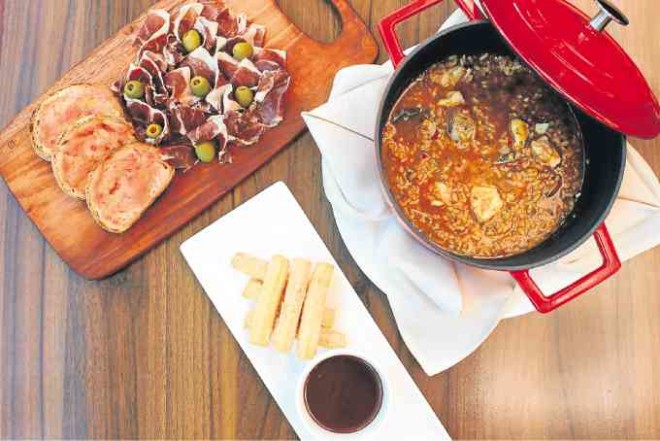
The recently held Madrid Fusión Manila 2017 ushered in several other food festivals of Spanish and Filipino regional food.
There was Diamond Hotel’s Exquisita Comida Española, which took the occasion to introduce its new Spanish chef, Francisco Javier Coque, who has worked with highly-rated restaurants in Spain, United States and England.
He is also no stranger to the food scene in the Philippines, having worked here in 2014 for a company that manages several Spanish restaurants.
Coque is from the Gran Canaria (Canary Island), an autonomous region of Spain off the Atlantic Ocean near Morocco.
Because there were many dishes at the Exquisita Comida Española opening, Coque pointed out a must-try, something from his birthplace. On a big paellera was Fideua de Mariscos, seafood paella whose main ingredient was pasta.
Long lines
At a dinner on the same day at the residence of Spanish Ambassador Luis Calvo, where his guests included Spanish chefs working in the Philippines, the diplomat explained that the fideua was devised when rice was difficult to get.
The grill attracted long lines, with seafood and chorizo roasting, plus the cochinillo (roasted suckling pig) at the carving station.
And in cazuelas were many other choices—familiar ones like Gambas al Ajillo (shrimp in garlic sauce), tortilla (potato omelet), croquetas (dumpling filled with chorizo or chicken) and Chipirones en su Tinta (stuffed squid with its ink).
There were also new items like the Panaderas, chicken with garlic baked with potatoes.
Chef Coque said this is usually cooked after the bakeries have finished with the breads and the ovens are still hot. It reminded me of the pig’s head that panaderias in the Philippines accommodate especially during fiestas.
But, always for me, the main attraction are the appetizers—
tapas in Spanish cuisine. And my mistake was to start with them, which made me half-full by the time the main courses were up for consideration.
The cold cuts (chorizo, jamon) on top of the pan con tomate (toasted bread with tomato and olive oil) will always make my day, along with the Spanish cheeses—Manchego and Idiazabal from sheep’s milk and Majorero from goat’s milk.
Pinoy food festival
On the other hand, the dinner hosted by Ambassador Calvo and his wife, Maria José Carrasco, was a Filipino food festival.
Appetizers served for cocktails included fried kesong puti (carabao’s milk cheese), mushroom cup with sisig and adobo samosa.
The salad was made with banana heart, straw mushroom and pako (fern fiddlehead) dressed with a pomelo vinaigrette.
The chicken cooked in coconut milk, yellow ginger and lemon grass was so tasty, as it had been marinated in its sauce before cooking. It was served with mountain rice, stuffed squash flowers and avocado. Dessert was turron ice cream in sesame tuile.
The stylishly done Filipino fare had me guessing which of the renowned caterers did the cooking. But Ambassador Calvo said it was by the embassy’s chef, Nicolas Quilao, who has worked with Glenda Barretto at Via Mare and in various food expos abroad.
At Madrid Fusión, the Department of Agriculture had several of our chefs cooking their version of the three major ingredients featured—rice, nose-to-tail and corn.
Claude Tayag, who was assigned on corn day, asked what he should do. I suggested suwam, of course—soup made with grated corn served with sili (chili) leaves. It is comfort food that can be mixed with boiled pork pata, shrimp, or served just by itself, very Filipino.
E-mail the author at pinoyfood04@yahoo.com.